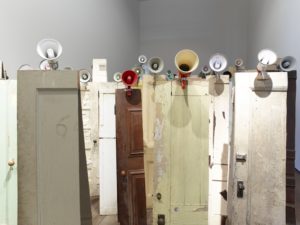
Kader Attia, Asesinos! Asesinos!, 2014, 134 wooden doors, 47 megaphones, dimensions variable, installation view, Australian Centre for Contemporary Art, Melbourne. Vehbi Koç Foundation Contemporary Art, Istanbul © the artist. Photograph: Andrew Curtis
Narrative Structures
Narrative structures have been experiencing a revival since the 1990s. Museum curators’ and exhibition makers’ interest is focused on narrative art in the present, and this has resulted in a large number of exhibition projects. Since this time, narrative structures and narrative dimensions in art have been increasingly discussed, but these are usually, besides a few exceptions, only recognised, without investigating them in a more differentiated and in-depth manner. There are hardly any narratologically influenced, art-historical analyses of contemporary narrative works of art, though there are a number of individual analyses of art up to the 19th century. It is therefore essential for an investigation of artistic-historiographical narrative strategies to clarify the concept of the narrative and the related terminology and define them for this research project.
One of the pioneers in the study of narrative structures in art is the art historian Wolfgang Kemp with his receptive-aesthetic approach. The narrative possibilities of moving and still images are also explored by the literary scholar Marie-Laure Ryan, who includes phenomena that usually are not (yet) considered narrative. The above-mentioned approaches from modern art history, literary and narrative theory will be pointedly illustrated using targeted questions: What can be called narrative in art? What constitutes the so-called “narreme”? How can a narratologically oriented investigation create a connection between modern art history and narratology and provide a concise definition of the narratological vocabulary?